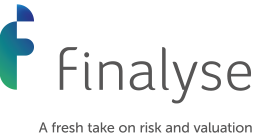How Finalyse can help
The impairment model will impact investment decisions and create additional challenges in your accounting, modelling and reporting functions
The highest possible predictive power of your models
Model Validation: are you sure your internal risk parameter estimates are adequate, robust and reliable?
The Impact of IFRS9 on Provisioning Behavior in Banks during Economic Shocks
Written by Prashant Dimri, Consultant.
Introduction
This article summarizes an ECB working paper which aims to talk about how the IFRS9 framework has impacted provisioning behavior in different banks, especially in the face of macro-economic shocks such as the COVID-19 pandemic and an energy price shock.
The International Financial Reporting Standard 9 (IFRS9) brought about a significant change in how banks calculate provisions for credit losses. Prior to IFRS9, the Incurred Loss (IL) model was used, which was essentially a backward-looking approach, triggering provisions only after default events had occurred. This model raised concerns about pro-cyclicality in the banking system, where provisions surged during economic downturns, leading to capital constraints and reduced lending capacity. To address these issues, the Expected Credit Loss (ECL) model, as embodied by IFRS9, was introduced globally. In the IFRS9 model, loans are categorized into three stages: Stage 1 (Performing), Stage 2 (Under-performing), and Stage 3 (Non-performing).
Provisioning Dynamics Under IFRS9
Under IFRS9, the provisioning methodology is more forward-looking compared to the IL model. Provisions are expected to be higher before the occurrence of a default event and are designed to be more responsive to economic shocks. However, an interesting observation is that a significant portion of provisioning still occurs at the time of or after default events, similar to the traditional accounting approach, known as national General Accepted Accounting Principles (nGAAP). This suggests that despite the shift to a more ECL-based framework, provisioning dynamics around default events have not fundamentally changed.
One key challenge that banks face in implementing IFRS9 is the identification of Significant Increase in Credit Risk (SICR) at an early stage. As a result, a substantial number of loans continue to be classified as Stage 1, which is the performing stage. This inability to move loans to Stage 2 (under-performing) shortly before default highlights the difficulty banks encounter in recognizing early signs of credit risk. Consequently, IFRS9 has not radically altered provisioning patterns in this regard.
Another noteworthy aspect is the role of discretion in banks' accounting practices. IFRS9 provides banks with some flexibility in provisioning, allowing them to provision less, especially if they have limited capital headroom. In contrast, banks with more capital headroom tend to increase provisions ahead of default for loans using IFRS9. While this flexibility can help less-capitalized banks avoid a significant increase in provisions during economic downturns, it also reduces transparency and may lead to under-provisioning, particularly for banks that are already at a greater risk due to their capital constraints.
Procyclicality in IFRS9
One of the primary concerns with IFRS9 is the potential for excessive procyclicality. A sudden and significant deterioration in economic conditions can lead to a sharp increase in loss provisioning even before actual default events occur. This, in turn, can reduce banks' capital positions and limit their ability to extend credit, exacerbating economic downturns. To mitigate this risk, authorities have introduced ad-hoc support measures such as encouraging banks to incorporate flexibility within the IFRS9 framework, implementing loan moratoria, or providing state guarantees.
The introduction of flexibility in IFRS9 allows banks to manage provisions in a way that aligns with their capital availability. While this can help reduce procyclicality, it also comes with a trade-off, as it diminishes transparency and makes it harder to gauge the true extent of credit risk within a bank's loan portfolio. The paper emphasizes that finding the right balance between flexibility and transparency is crucial, as excessive flexibility can lead to under-provisioning, which may have systemic implications if significant losses materialize.
Exposure to Macro-Economic Shocks
The paper also examines the impact of macro-economic shocks on provisioning dynamics, particularly focusing on the energy price shock in 2022. The study uses loan data matched with an energy intensity measure constructed by the European Central Bank, which helps identify sectors heavily dependent on energy inputs, such as industrial and construction sectors.
When considering the impact of the COVID-19 pandemic, the paper finds that banks with higher capital levels tend to make more provisions. Better-capitalized banks are also more likely to move loans to Stage 2 under IFRS9. In the case of the energy price shock, provisions for IFRS9 loans increased significantly for energy-intensive sectors after the shock. Banks with more capital headroom again responded by increasing provisions more than their counterparts.
Regression Strategy
To analyze the impact of accounting standards and bank characteristics on provisioning behavior, the paper employs three types of regression tests:
Determinants of Provisioning Ratio: This analysis focuses on understanding the general drivers of provisioning behavior. It assesses changes in the provisioning ratio at the bank-firm level, with variables like accounting standard (IFRS9 vs. nGAAP), bank capitalization etc.
Provisioning Dynamics around Idiosyncratic Credit Events: By examining provisioning dynamics around individual loan-level events, it aims to identify potential cyclical implications of different accounting standards and bank practices. In other words, whether provision dynamics are generally different between loans using different accounting standards or loans issued by different banks which derive insight on cyclical implications.
Provisioning Dynamics around Macro-Economic Shocks: This analysis investigates provisioning dynamics during macro-economic shocks, such as those triggered by the COVID-19 pandemic and the outbreak of war in Ukraine. These events have broader systemic implications, and understanding their impact on provisioning is crucial.
The results of the analysis indicate that, as intended, provisions under IFRS9 are higher than those under nGAAP. During the COVID-19 pandemic, non-performing loans improved, but there was a noticeable increase in Stage 2 provisions. Banks with more capital headroom tend to make higher provisions, consistent with capital management motives. The analysis also highlights the influence of discretion on provisioning behavior.
Conclusion
In conclusion, this paper provides valuable insights into the functioning of IFRS9 under real-life economic stress, supported by loan-level data. Future research should continue to assess the impact of IFRS 9 on financial stability and the lending behavior of banks in various economic scenarios. Certain challenges persist, such as the difficulty in identifying SICR at early stages, leading to most of the provisioning occurring at the time of default. Provisioning dynamics between IFRS9 and nGAAP remain rather similar.
Furthermore, the paper emphasizes the importance of accounting flexibility in mitigating potential procyclical effects after an economic shock, particularly for less-capitalized banks. However, this flexibility comes at the cost of reduced transparency, potentially leading to under-provisioning and systemic risks if losses materialize. Future research should continue to assess the impact of these factors on financial stability and the lending behavior of banks in various economic scenarios. It is crucial to strike a balance between flexibility and transparency to maintain the resilience of the financial system while avoiding undue procyclicality.
Reference
Finalyse InsuranceFinalyse offers specialized consulting for insurance and pension sectors, focusing on risk management, actuarial modeling, and regulatory compliance. Their services include Solvency II support, IFRS 17 implementation, and climate risk assessments, ensuring robust frameworks and regulatory alignment for institutions. |

Our Insurance Services
Check out Finalyse Insurance services list that could help your business.
Our Insurance Leaders
Get to know the people behind our services, feel free to ask them any questions.
Client Cases
Read Finalyse client cases regarding our insurance service offer.
Insurance blog articles
Read Finalyse blog articles regarding our insurance service offer.
Trending Services
BMA Regulations
Designed to meet regulatory and strategic requirements of the Actuarial and Risk department
Solvency II
Designed to meet regulatory and strategic requirements of the Actuarial and Risk department.
Outsourced Function Services
Designed to provide cost-efficient and independent assurance to insurance and reinsurance undertakings
Finalyse BankingFinalyse leverages 35+ years of banking expertise to guide you through regulatory challenges with tailored risk solutions. |

Trending Services
AI Fairness Assessment
#ResponsibleAI
#AIFairnessAssessment
CRR3 Validation Toolkit
#CRR3Validation
#RWAStandardizedApproach
FRTB
#FRTBCompliance
#MarketRiskManagement
Finalyse ValuationValuing complex products is both costly and demanding, requiring quality data, advanced models, and expert support. Finalyse Valuation Services are tailored to client needs, ensuring transparency and ongoing collaboration. Our experts analyse and reconcile counterparty prices to explain and document any differences. |

Trending Services
Independent valuation of OTC and structured products
#IndependentValuation
#StructuredProductsValuation
Value at Risk (VaR) Calculation Service
#VaRCalculation
#RiskManagementOutsourcing
EMIR and SFTR Reporting Services
#EMIRSFTRReporting
#SecuritiesFinancingRegulation
Finalyse PublicationsDiscover Finalyse writings, written for you by our experienced consultants, read whitepapers, our RegBrief and blog articles to stay ahead of the trends in the Banking, Insurance and Managed Services world |

Blog
Finalyse’s take on risk-mitigation techniques and the regulatory requirements that they address
Regulatory Brief
A regularly updated catalogue of key financial policy changes, focusing on risk management, reporting, governance, accounting, and trading
Materials
Read Finalyse whitepapers and research materials on trending subjects
Latest Blog Articles
Contents of a Recovery Plan: What European Insurers Can Learn From the Irish Experience (Part 2 of 2)
Contents of a Recovery Plan: What European Insurers Can Learn From the Irish Experience (Part 1 of 2)
Rethinking 'Risk-Free': Managing the Hidden Risks in Long- and Short-Term Insurance Liabilities
About FinalyseOur aim is to support our clients incorporating changes and innovations in valuation, risk and compliance. We share the ambition to contribute to a sustainable and resilient financial system. Facing these extraordinary challenges is what drives us every day. |

Finalyse CareersUnlock your potential with Finalyse: as risk management pioneers with over 35 years of experience, we provide advisory services and empower clients in making informed decisions. Our mission is to support them in adapting to changes and innovations, contributing to a sustainable and resilient financial system. |

Our Team
Get to know our diverse and multicultural teams, committed to bring new ideas
Why Finalyse
We combine growing fintech expertise, ownership, and a passion for tailored solutions to make a real impact
Career Path
Discover our three business lines and the expert teams delivering smart, reliable support


